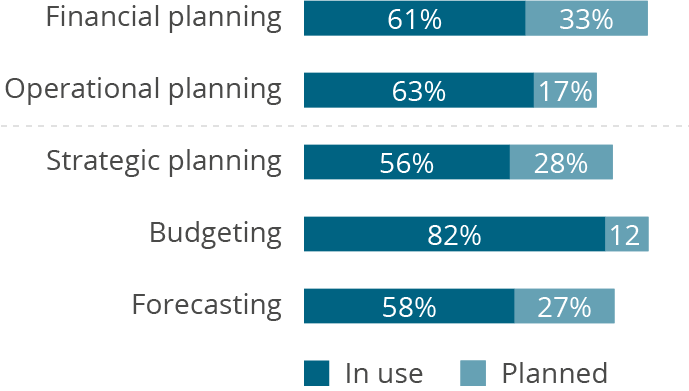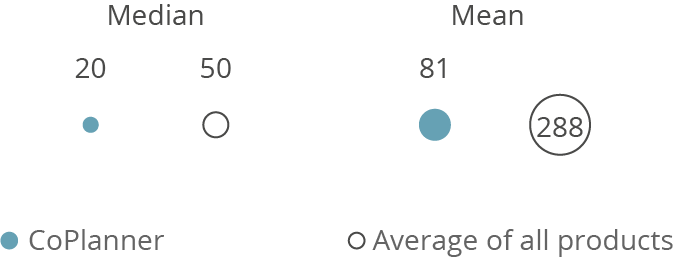CoPlanner
CoPlanner was founded in 1989 in Graz, Austria. The company was founded with the aim of supporting enterprises with the appropriate tools so that they can make sound and reliable decisions quickly. The vendor currently employs about 40-50 people and claims to have more than 150 active customers, primarily in Austria, Germany and Switzerland.
CoPlanner is a one-product company. Since 2003, it has provided its eponymous planning and CPM software. CoPlanner is a flexible product for building individual planning, reporting and financial consolidation solutions and offers various specialist applications as well as prebuilt models that are parameterized for implementation. Data and metadata is stored in Microsoft SQL Server or Microsoft Azure SQL Database. Additionally, the vendor uses in-memory data storage on the CoPlanner server for multidimensional preparation of data, which is synchronized simultaneously with the relational database. Essentially, the product is a flexible development environment for all kinds of planning approaches (top-down, bottom-up or combinations of both). Business power users typically use it to create wizard-based individual planning, budgeting and forecasting applications requiring only minimal IT support (e.g., for data integration tasks or data storage).
At the heart of the product is CoPlanner’s comprehensive functionality for corporate planning. The development environment provides flexible modeling of individual planning, budgeting and forecasting applications. Moreover, standard models are offered for, among other things, integrated financial planning (balance sheet, P&L, cash flow), financial consolidation, cost-performance accounting, HR planning and solutions for various sub-plans (e.g., sales planning, investments, production planning). In typical implementations, CoPlanner is used by 30 to 40 concurrent users. However, there are implementations with smaller and also much larger numbers of users.
CoPlanner customers usually start off with planning, budgeting and forecasting projects but often have additional requirements for reporting, analysis or financial consolidation. For standard formatted reporting, a business-user-friendly reporting module enables the creation of on-screen reports as well as formatted print reports. Comprehensive options are available for formatting and tabular layouts as well as graphical reports. Moreover, for ad hoc query and individual analyses, CoPlanner Analyzer and a feature-rich Excel add-in are available. Add-ins for Microsoft PowerPoint and Microsoft Word are also provided. Finally, CoPlanner data can be imported and consumed in Microsoft Power BI leveraging REST APIs.
The certified (IDW PS 880) CoPlanner Consolidation module completes the portfolio with functionality for legal and management consolidation.

User & Use Cases
81 percent of CoPlanner users are planning users – significantly above the survey average of 69 percent – reflecting the fact that CoPlanner is essentially a planning, budgeting and forecasting platform rather than a BI and analytics tool. This is also born out in its typical use cases. Customers leverage CoPlanner mainly for operational planning (63 percent) but also financial planning (61 percent). Here, planning takes place at different aggregation levels. CoPlanner is used for budgeting (82 percent), forecasting (58 percent) and strategic planning (56 percent). Besides planning, customers mainly use it for standard/enterprise reporting (76 percent), ad hoc query (67 percent) and analysis (52 percent). Many respondents also plan to use it for dashboards/BI applications (47 percent), financial planning (33 percent), strategic planning (28 percent) and analysis (28 percent) in the future.
CoPlanner targets companies of all sizes across all industries, predominantly in the DACH region (Germany, Austria and Switzerland). 86 percent of our sample of CoPlanner customers come from mid-sized companies (100-2,500 employees) with a median of 20 users (including 15 using planning functionality), but the mean of 81 users (67 for planning) indicates there are also some larger implementations.
Current vs. planned use (planning use cases)
N=35

Current vs. planned use (besides planning)
N=35

Total number of users per company
N=35

Planning users per company
N=35

Percentage of employees using CoPlanner
N=35

Planning users (as a percentage of all users)
N=35

Company size (number of employees)
N=35

Versions used
N=26

Want to see the whole picture?
BARC’s Vendor Performance Summary contains an overview of The Planning Survey results based on feedback from CoPlanner users, accompanied by expert analyst commentary.
Contact us to purchase the Vendor Performance Summary- Register for a free sample Vendor Performance Summary download
- If you have any questions, feel free to contact us
